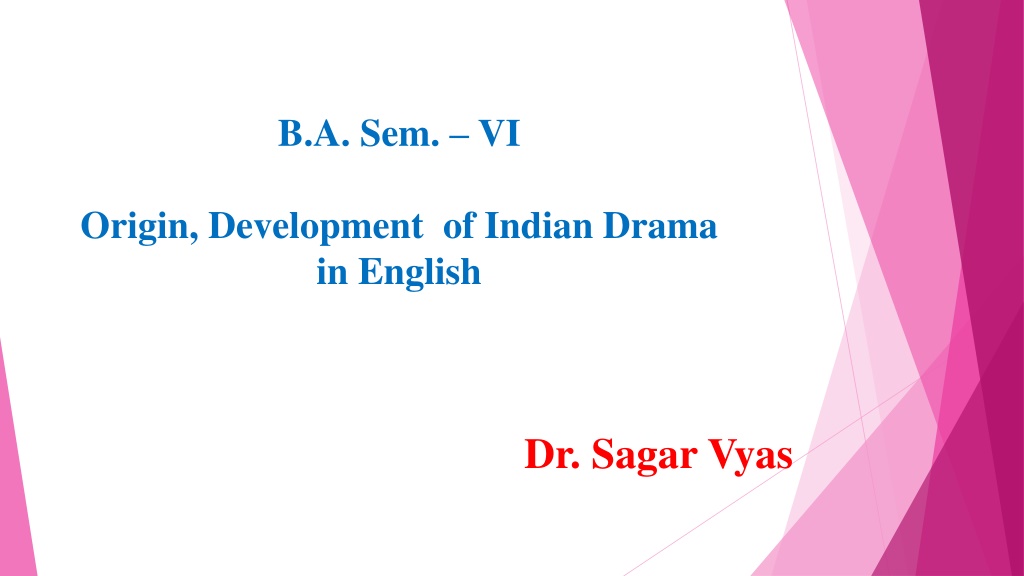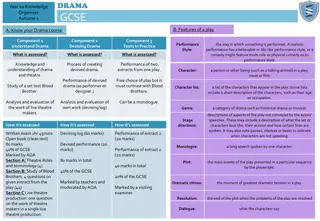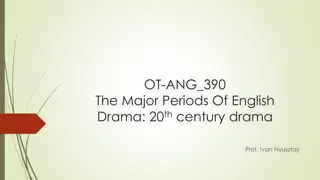Origin and Development of Indian Drama in English
Indian English Drama has a rich history, starting from the Sanskrit plays of the Vedic Age to prominent playwrights like Rabindranath Tagore and Sri Aurobindo Ghosh. The genre saw a resurgence in the 20th century with significant contributions from various playwrights marking its evolution through social, historical, and romantic themes, reflecting the cultural and societal shifts in India. The art form encompasses a blend of traditional Sanskrit elements and Western influences, shaping a unique narrative in Indian drama.
Download Presentation

Please find below an Image/Link to download the presentation.
The content on the website is provided AS IS for your information and personal use only. It may not be sold, licensed, or shared on other websites without obtaining consent from the author. Download presentation by click this link. If you encounter any issues during the download, it is possible that the publisher has removed the file from their server.
E N D
Presentation Transcript
B.A. Sem. VI Origin, Development of Indian Drama in English Dr. Sagar Vyas
Origin, Development of Indian Drama In English [1] Introduction Drama is a composite art form. It is mimetic like all other performing arts in literature. It imitates life, particularly reflecting the three unities of time, place and action. It is designed for representation on the stage by actors who act the parts of the characters of its story, and among whom the narrative and the dialogue are distributed. Though India has a long and fertile history in Drama, starting from Sanskrit plays of Vedic Age, the Indian English Drama started its innings only in the nineteenth century, with the publication of Krishna Mohan Banerjee s The Persecuted in 1813. A social play, it brought to light the conflict between the East and the West. Madhusudan Dutt s Is This Called Civilization? which was published in 1871 is reckoned as the real starter of the Indian English Drama. Later he translated his Bengali plays, Ratnavali and Sermista into English.
After a lull for a few decades, Indian English Drama came back to life in the 20th century. The Pre-independent Indian playwrights were Rabindranath Tagore, Sri Aurobindo Ghosh, T.P. Kailasam, A.S.P. Ayyar, Harindranath Chattopadhyaya Bharati Sarabhai. Their works signalled the coming back of Indian English Drama. Rabindranath Tagore and Sri Aurobindo Ghosh, two great names in Bengal Renaissance, held the light for the onward march of the Indian English Drama.
History of Indian Drama It starts from the Sanskrit plays. The Indian theory of drama preserved in Natyashastra. It says that the drama is a divine origin, and is connected to the sacred Vedas. The well-known ancient dramatists are Ashwagosh, Shudraka, Bhasa, Kalidasa, Bhavbhut, Harsha, Vishakhadatta etc. The tragedies i.e. Urubhanga, romances i.e. Abhijnana-sakuntalam and historical plays i.e. Mudrarakshas are the well-known plays of the Vedic period. The Sanskrit literature can be classified into two categories: Drishya (that can be seen) and the Sravya (that can be heard).
Drama comes in the category of Drishya. Drama is considered under broad concept of Rupaka in Sanskrit which stands for the depiction of human life in different aspects and represented by the actors in the form of drama. The Indian English Drama began in the 18thcentury when British Empire came and strengthened its political power in India. It is started with the publication of Krishna Mohan Banerjee s The Persecuted in 1813. It is a social play in which the author tries to present the conflict between the East and the West. The real development of Indian English Drama is started with the publication of Madhusudan Dutt s Is This Called Civilization in 1871. He also translated Ratnavali (1859) and Sermista (1859) into English, originally written in Bangla. Rabindranath Tagore, T. P. Kailasam, Aurobindo Ghosh, A.S.P. Ayyar, Bharati Sarabhai, Harindranath Chattopadhyaya, who made a significant contribution to the development of Indian English Drama. Rabindranath Tagore, SirAurobindo Ghosh and Harindranath Chattopadhyaya - are known as big three Chitra, Sacrifice, The Post Office, Muktadhara, The Cycle of Spring, The King of the Dark Chambers well known plays
The philosopher, writer and teacher Rabindranath Tagore unifies Indian and western traditions creating plays which are the mixture of Bengali folk drama and Western medieval mystery plays . - Diana Devlin SirAurobindo (1872-1950) was also one of the major Indian English Play wright. He wrote five complete and six incomplete poetic plays during 1891-1916. The variety of periods ranging from ancient Greece to medieval India and the places divers lands including Iraq, India, Syria, Britain, Spain and Norway. All his plays are revolve around poetry and romance. His famous plays are: The Viziers of Bassora, Perseus the Deliverer, Price of Edur, Eric Savitri and Vavadutta. Sir Arurobindo used the ancient legends to highlight the contemporary urge for freedom relation and then heighten the elements of heroism, mystery and adventure in the actions of his characters in his plays.
Harindranath Chattopadhyaya who added a new dimensions to Indian English drama. He influenced greatly by the progressive writers movement. He sympathizes with the underdogs same like Mulk Raj Anand. He is more eminent as a poet than the playwright. His plays related to society highlight social protest and the ideas related to revolution. His plays can be divided into four categories: Social, Devotional, Historical and Miscellaneous. Five Plays (1937): The Windows, The Parrots, social plays The Santry Lantern, The Coffin and The Evening Lamps. These plays have a didactic purpose and marked by realism.























